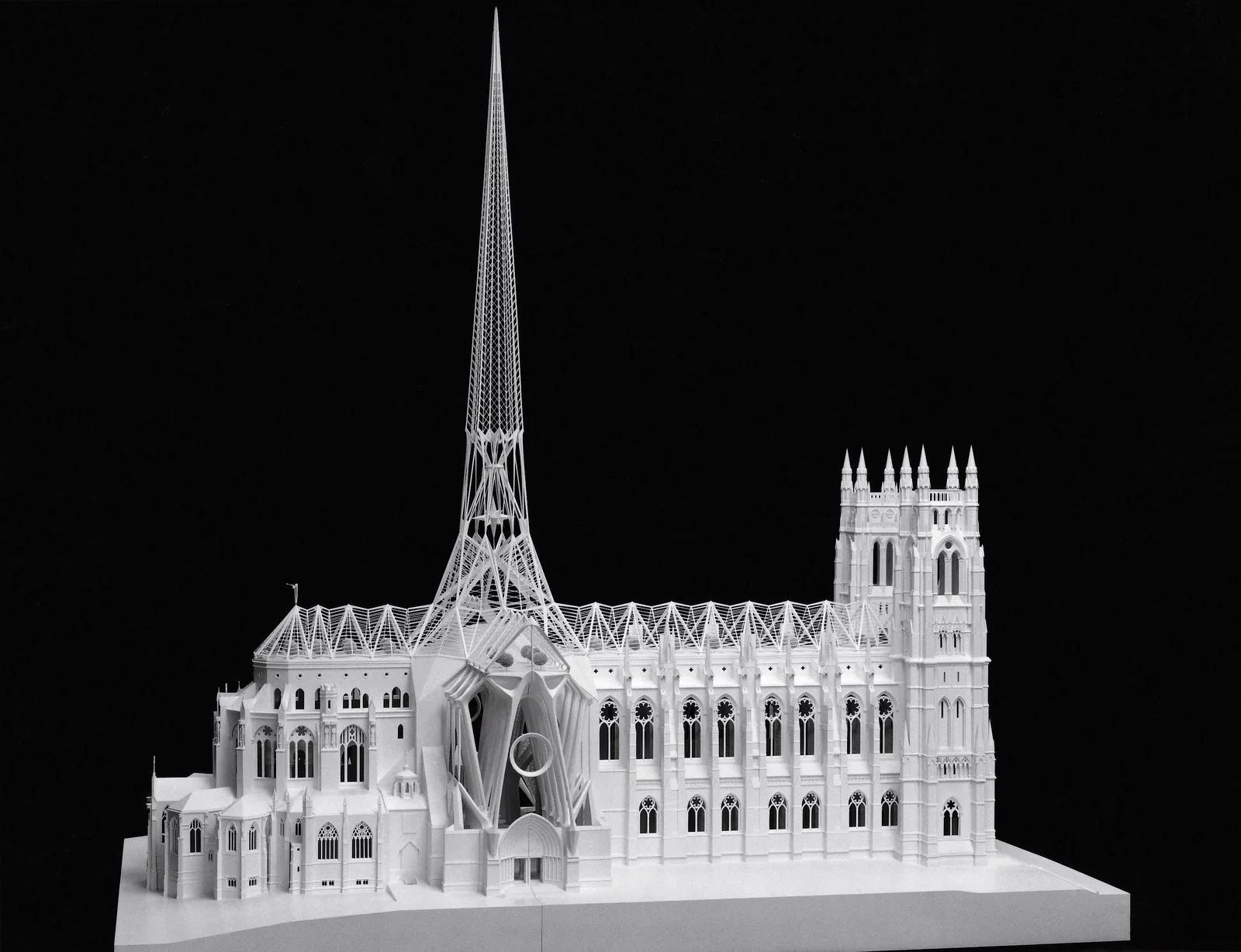One of my Favorite Projects
Saint John the Divine in New York City is one of my favorite buildings. Oddly, the project was never constructed and remains forever locked as a design. It was designed by Spanish Architect and Engineer Santiago Calatrava. His work is very intricate and delicate, mimicking the human body and structure. He is also a sculptor that uses mass, wire and rods to balance a variety of forms that seem to levitate.
The project was an addition to a structure that already exists. The design is a type of integration of form and structure where the two architectural concepts, old and new, collaborate as one. Interestingly, the existing cathedral as it is now was never completed. One of the front towers is truncated and the central spire was never built. Calatrava came in to rectify that and bring the cathedral into its envisioned grandeur.
The cathedral design takes us back to a time when religious structures dominated the landscape and reached for the sky. These great churches were taller and more grand than any fortress or castle and to this day, many beautiful cities of the world still place their cathedrals as the primary buildings that all others surround.
It still fascinates me how long these projects took to construct. The construction spanned many generations and a mason or carpenter that started the project clearly understood that he, nor his children, or his grandchildren, quite possibly his great grand children, would never see the building as a completed work. Yet, they still moved forward with great motivation and skill creating work that they would never see, but still stands with tremendous fortitude today.
The unbuilt project at St. John the Divine speaks to that level of impeccable craft. The projects points to the beauty of engineering and the human determination to build and build beautifully. IN much of our current work we have lost this and works of art in the built environment is relegated into a few architects that are willing to bear the load of pushing the architectural craft forward. These works are very expensive and sometimes lack justification. This makes the public wary and suspicious, sometimes angry.
Our temples in the modern world are the skyscrapers of our corporate religion whose products we worship. Even that is changing as many of the most powerful technology companies have rejected the vertical structures for more linearly oriented campuses modeled in an academic where circulation and interactions are critical.
It is important that architect’s continue to push the boundaries of the craft even though we are demonized. Many architects were seen that way even long ago, only to see their great works celebrated in the future. In many countries that I have visited, architects are respected and revered. In France, I was amazed to find out that architects gain discounted entry to some museums and galleries.
We do have the responsibility to be financially sound and regulate costs, but we must breathe new air into the built environment. It is necessary to support life and human forward movement. If you look at all the diverse landscapes on Earth, you will seldom see a stark landscape that is habitable or at least voluntarily habitable. Deserts exist in super hot and super cold climates; one with sand, the other with snow and ice. The singularity of the open ocean is another example of a oneness of material - water.
If you go to the jungle, you will see an explosion of color and creature. There are thousands and thousands of species and forms of rocks and plants. The built environment is similar, it needs to be a vibrant and differentiated space that can consume the human interest. When humans are interested and curious and filled with wonder, we gather and consume. When the environments are harsh, climatically and visually, we are pressured and prone to conflict.
The term “Concrete Jungle,” typically used to describe tough, underserved neighborhoods where there is a lot of violence is misworded. They should be labeled “Concrete Deserts.” Although a jungle is a place where the food chain dominates, a desert is severe in every way. A jungle is so full of life and energy where a desert is at a lack of it.
I take this approach when I view opportunities for urban transformations. I drive by these areas and see new projects being built. I see new buildings but not new ideas. I see new housings, but not new lifestyles. I see fresh materials being erected, but not a new way of thinking about the neighborhood. These new projects are already drab and obsolete the moment that first tenant moves in to being a new life, or continue that same one they never left behind.
I reject that status quo, and I guess fortunately for me, that status quo rejects me. When viewed from that angle there is a great balance and I will have the opportunity to execute the oppositional position and create harmony within the transformation of the built environment and nature itself. If not, I presume the universe will implode.
Until then, view the magnificence of St. John the Divine, unbuilt, but not unloved.


